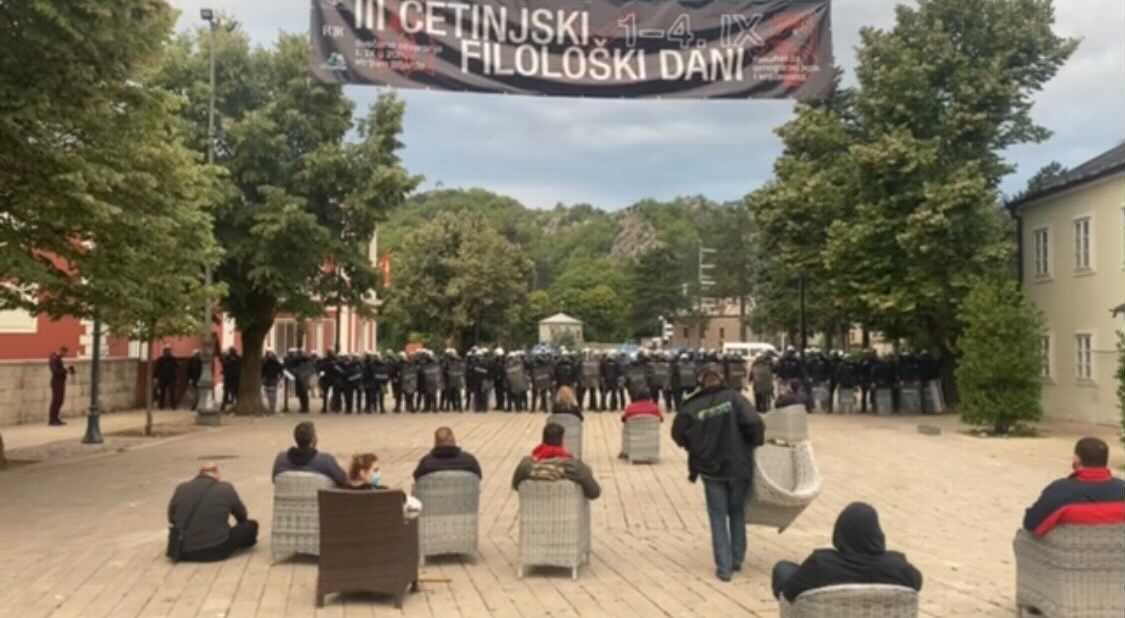The anointment of the Metropolitan of Montenegro and the Littoral of the Serbian Orthodox Church (SOC) Joanikije (Micovic) in Cetinje on September 5, renewed the atavisms of mutual historical conflicts of the two opposing concepts and narratives – the Greens and the Whites, Partisans and Chetniks, sovereigntists and unitarists, thus deepening the ambiance of existential crisis and lapsing the Montenegrin society. This friend–foe atmosphere demonstrated the fragility of the civic character of Montenegrin society, oppressed by the growing clericalism. The burden of the divided interpretations of the past and outlooks on the future, frequently limited by dogmas, is an obstacle in all serious efforts to establish the culture of social dialogue.
In such a historical context, it is valid to observe the insistence to anoint a new Metropolitan in the Cetinje Monastery, in this specific social moment at all costs. The great part of Montenegrin public perceived this act as a manifestation of the cultural and political aggression and power of Belgrade, and an occasion to show that Montenegro is a part of the Serbian world, while others, loyal to that religious community (SOC) see no harm in such act.
Despite the estimation of the intelligence and security sector that no one can guarantee for the security in Cetinje and in spite of dissonant tones in the Government, Metropolitan Joanikije and Serbian Patriarch Porfirije arrived in Cetinje by helicopter, followed by the Special Police Unit, while the police forces in the very center of the Montenegrin Royal Capital were breaking through the barricades and protesters’ line firing tear gas and shock bombs. After the short ceremony, they came back to Podgorica the same way.

Separating the church from the state
During the years-long existence of the State and the Church, the Church practice ordered that the Metropolitan is anointed and resides in Cetinje, as a spiritual and state center of Montenegro, whose backbone was the Metropolitanate of Cetinje. The role of the Church until its formal separation from the state in 1852 was the decisive one in almost all the social spheres – education, first forms of the direct democracy and political life, and her role in the centuries-long defense of Montenegro from the emperors is particularly special. The Cetinje Monastery was the center of the most important state institutions, a place of gathering where the crucial events occurred. Today, however, the perception of the essential and symbolic significance of the Church is subject to politicization and it is a clear line that Montenegro is divided upon.
Negation of Montenegrin identity in the appearances of the SOC representatives and placing the religious in the space of politics (especially in the context of the SOC role in the election and post-election processes during 2020 and 2021) resulted in accentuated social polarization and problematization of the venue of anointment, bearing in mind the significance of the Royal Capital in the creation of the state. The attitude of the government undoubtedly contributes to this, since not only it failed to protect its institutions from the Church influence, but it emerged as its direct product.
Pro et contra anointment
Aside from the turbulent domestic scene divided into two wings, the anointment of the Metropolitan of Montenegro and the Littoral Joanikije caused reactions of the actors from the region and international community. Defending his own restrained attitude, President of Serbia Aleksandar Vucic at first reminded that his job was to take care of the interests of his people.
The Serbian President gave a statement soon after the disapproved anointment in the Cetinje Monastery, affirming the role that the Government of Montenegro and its law enforcement bodies, as well as the Serbian Security Information Agency (BIA), had in this act. On that occasion, we found out that the Government of Montenegro planned to postpone the anointment, but that decision was changed overnight. The information on postponement of the anointment was republished by the media that are declared as Serbian pro-regime in the information environment. On the other hand, the Government of Montenegro assured that the postponement of the ceremony in Cetinje was not considered, which leaves room to doubt the truthfulness of the statements from the Prime Minister’s Office but also to ask a legitimate question whether it was decided in Montenegro if the anointment would(not) take place.
Other Serbian officials were less reserved in their statements, including President of the Parliament of Serbia Ivica Dacic, Minister of Interior and bastion of the Serbian World Aleksandar Vulin, who agreed that there were forces in Montenegro that had been working on creating divisions between the Serbian and the Montenegrin people for decades. For them, Djukanovic’s invitation to move the venue of anointment has nothing to do with the Church but only with his own interests to remain in power after he had felt that particular danger lurks from Serbian and the Serbian Orthodox Church.
The Serbian media machinery working for the SOC and the regime
The media controlled by the Serbian Government support the attitudes of Belgrade, which declaratively advocates for good Serbia-Montenegro relations, even though it is openly creating tensions. Judging by the Serbian media, Cetinje is a center of Montenegrin separatism and anti-Serbian ideologies. Besides launching disinformation, Belgrade-based tabloids were frequently alluding to civil war and bloodshed.
After the narrative on calling for blood and unrest in Cetinje, along with those on the state of war and the lynch of Serbs, the Serbian pro-regime tabloids started to report on the unsuccessful coup in Cetinje immediately upon the anointment, followed by applauds to Deputy Prime Minister Abazovic who, according to them, saved the day.
Even though the Agency for Electronic Media limited broadcasting of the programs on the Serbian televisions in February last year, since they were promoting hate, intolerance, and discrimination, it did not do it now, despite numerous inflammatory messages that were continuously sent before September 5 and on the very day of the anointment.
However, the Council of the Agency for Electronic Media is working on a detailed and thorough analysis of the debatable content launched by Happy TV and limiting the content will be a topic during one of the following sessions, announced President of the Council of the Agency for Electronic Media Branko Boskovic.
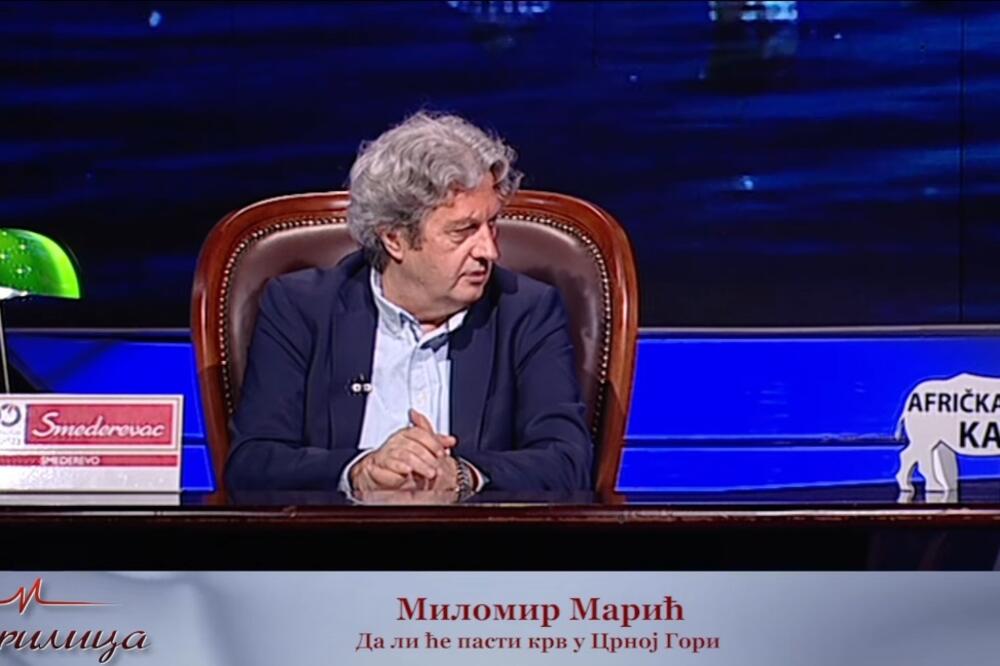
TV show Cirilica on Happy TV, prepared and hosted by Milomir Maric, on the topic Will bloodshed occur in Montenegro was broadcast on August 30, which indicates that the disturbing bloodshed-inciting narratives are not limited to the headlines of the Serbian tabloids. The media that brutally discredit political opponents in order to incite the conflicts while at the same time promote and spread hate speech are mobilizing the masses and may be fatal for anyone that gets trapped into their media manipulation.
Inflammatory online hate speech
Meanwhile, there was a struggle without respite on social media between two wings, one shouting that it was time for the National Montenegrin assembly and another one impatiently waiting for the anointment of the Metropolitan Joanikije in Cetinje. However, the recent arrest of a person who threatened to slaughter and kill in Cetinje on social networks, but also the increasing threats that Cetinje will be the new Srebrenica testifies that this struggle has left the normative framework on freedom of expression online a long time ago. This period of tension created continuous threats, fake news, and disinformation on the anointment such as the one on the announced concert of Jadranka Barjaktarevic and Marko Perkovic Thompson on the gathering of the anointment opponents, which has never been planned. Similar manipulation occurred on August 29 when the unknown perpetrator abused the Radio and Television Cetinje and attempted to discredit that media by publishing fake news supporting the anointment of Metropolitan Joanikije.
The precise figures indicate that the issue of anointment was a burning one in the online world. In the period between September 1 and 7, there were 11.244 posts on Facebook that generated an incredible 1.674.030 interactions. In the same period, there were 43.600 posts on Twitter while the topic of Cetinje appeared in 17.100 articles in the media.


Manipulating via fake news and disinformation
Besides having recognized that no one can be guaranteed safety in Cetinje, the Government of Montenegro did not give up on the anointment being organized in Cetinje. That decision was met with criticisms among both the national and broader public.
That is the reason why the media Vijesti tried to justify the Government’s decision by publishing a survey from NGO Nova srpska politicka misao (the New Serbian Political Thought) on alleged support (amounting to 54.2%) of the citizens of Montenegro to Metropolitan Joanikije’s anointment in Cetinje.
The Institution’s research is disputable since its President Djordje Vukadinovic, a Serbian nationalist, Russophile, and opponent to the Montenegrin independence distanced himself in 2015 from research on the social and political situation in Montenegro published by his own organization. Vukadinovic was not familiar with the methodology and he admitted that he was asked to present the research to the public, even though he did not say by who. He is a member of the so-called Committee on Defense of DF leaders Andrija Mandic and Milan Knezevic and other persons accused of the 2016 coup attempt. The Committee consists of other negators of Montenegro and the Montenegrin identity such as Cedomir Antic and Aleksandar Rakovic. Publishing unverified surveys such as this, particularly in a situation where the tensions already exist, does nothing but increases additional tensions and polarization in our society.
The media in Montenegro and Serbia spread disinformation on alleged police repression towards Montenegrin, i.e. Serbian people in the country. The narrative spread depended on the political affiliation of the media. The pro-Montenegrin media wrote about repression towards Montenegrins, while the Serbian media wrote about repression towards Serbs. These were typical examples of fake news with a view to raise tensions and radicalize citizens of both nationalities. In cooperation with the Police Directorate, the DFC successfully denied those allegations.
A series of Montenegrin media published fake news on bus convoys packed with people traveling from Belgrade to Podgorica to support the anointment. However, on that very day, Montenegrin borders did not witness any bus convoys or greater crowds that would underpin such allegations.



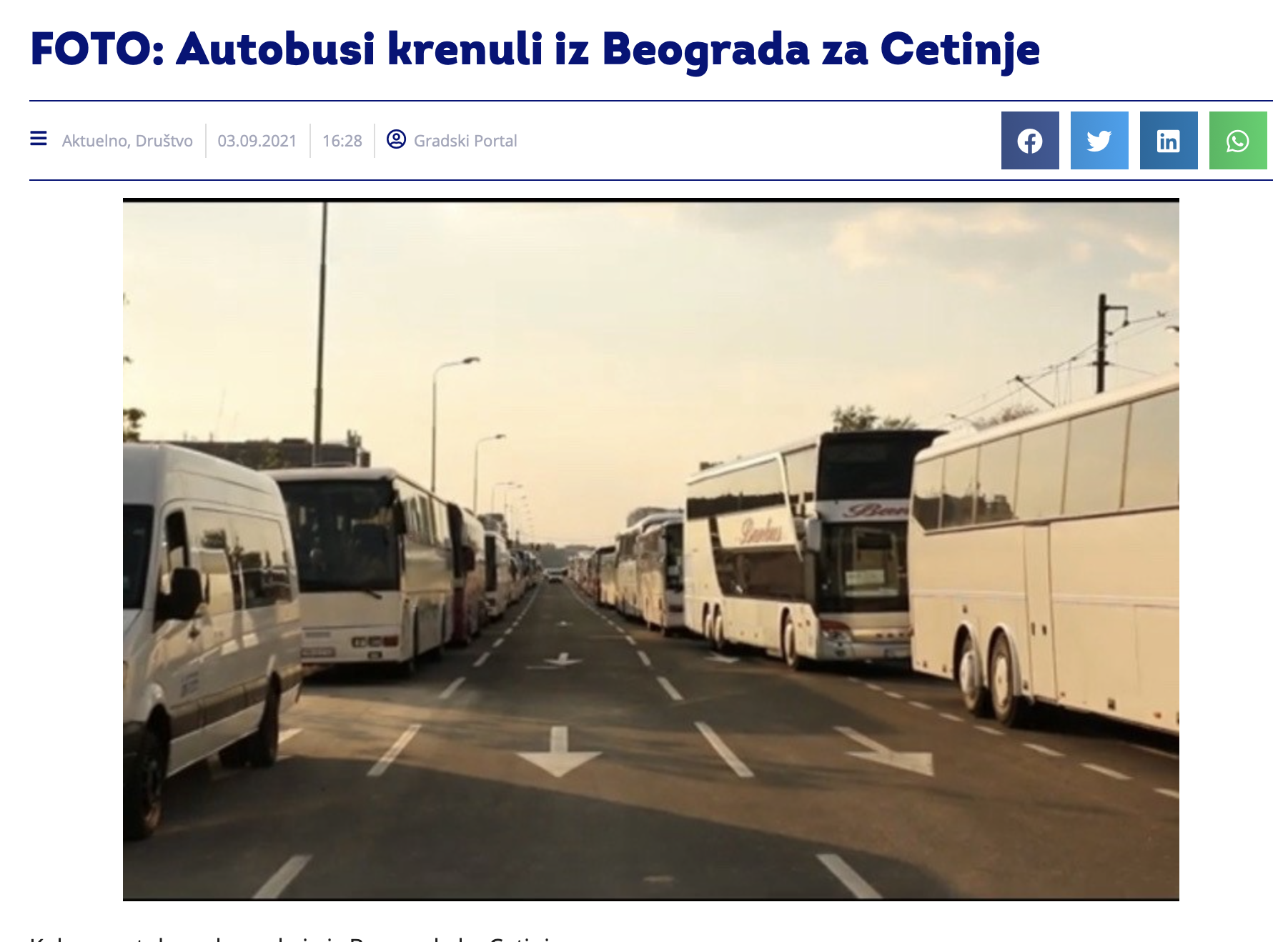
The coordinated actions of pro-Serbian and pro-Russian Facebook pages were registered at the very beginning of the protest in Cetinje. Inflammatory rhetoric and coordinated actions on Facebook pages coming from Serbia were performed on the pattern used during the local elections in Niksic, with tens of pages simultaneously posting fake and sensationalistic news on the events in Cetinje. More coordinated actions were registered during the day, and a threat of such operation was significantly bigger than usual, bearing in mind that a total number of people following those pages exceeds 580,000. Furthermore, during the day, Serbian tabloids were continuously spreading disinformation and fake news, while reporting in a sensational manner. One of the fake news was that the Democratic Party of Socialists (DPS) provided young men, who were getting prepared to create chaos, with T-shirts with Serbian hallmarks to put on. That day, there were no young men wearing T-shirts with Serbian hallmarks in Cetinje.

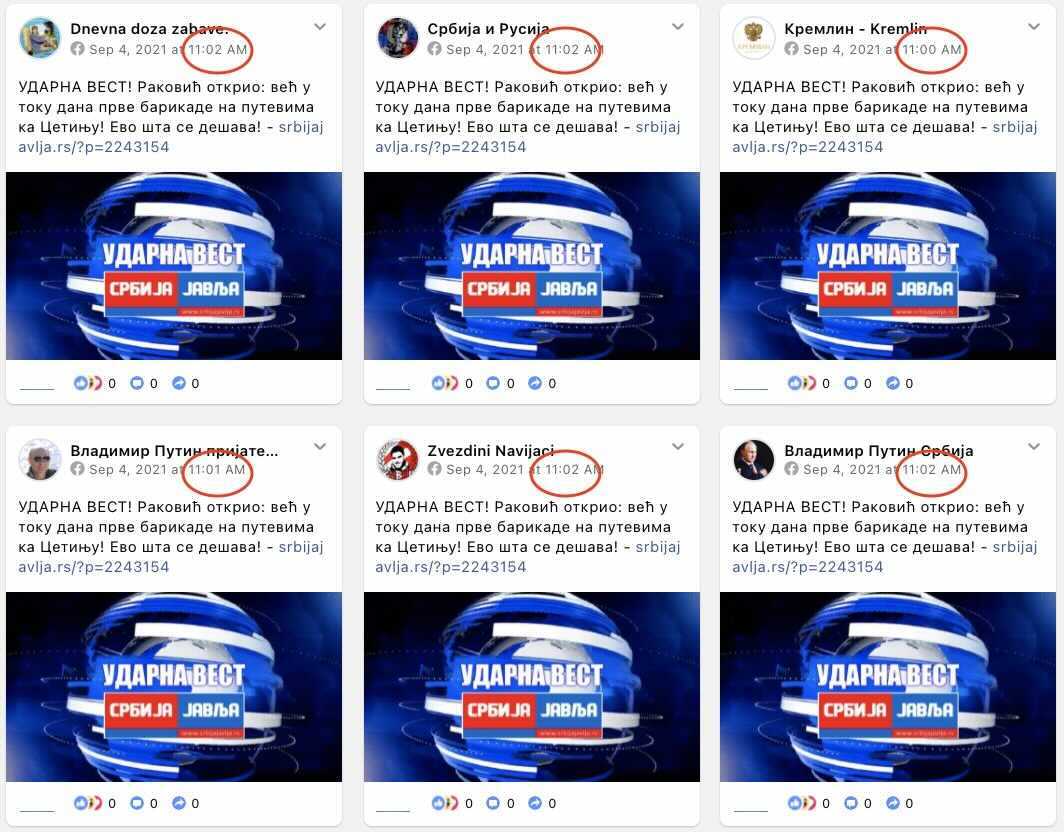
Cocktail as a trigger for the police action
One of the most dangerous disinformation during the protest in Cetinje was launched by the ones who were, in those moments, supposed to give as precise information as possible. In fact, the announcement from Prime Minister Zdravko Krivokapic’s Office was published on the Vijesti portal at 06:16 a.m. stating that protesters threw a Molotov cocktail on the Police members. Information that certainly worried all Montenegrin citizens was, in fact, fake news. Our people operating on the field, as well as journalists from other media, including a journalist from Vijesti, confirmed it was fake news. She reported that she neither saw nor heard that such an incident had happened. Almost all media from Serbia republished that fake news.
It is very indicative that the news was published at the moment when the police started implementing strong measures against the protesters. It is evident that the Prime Minister’s Office intended to justify started police intervention. Deputy Prime Minister Dritan Abazovic tried to justify the police intervention as well, in a breaking news block on TV Vijesti, where he demonstrated a photo of a protestor holding the Molotov cocktail. However, even without having special knowledge of digital forensics, one can easily determine from the photo that the time when it was captured does not coincide with the time when the police action started. The photo was taken three hours after the police intervention and the announcement from the Prime Minister’s Office. The following day, the Prime Minister himself said at the press conference that he did not know when the photo, that was supposed to be key evidence for the Office’s announcement, had been taken. If it is the same photo, it will be interesting to see how Prime Minister is going to explain that, at the moment of publishing the press release, he already had a photo taken three hours after its very publishing.
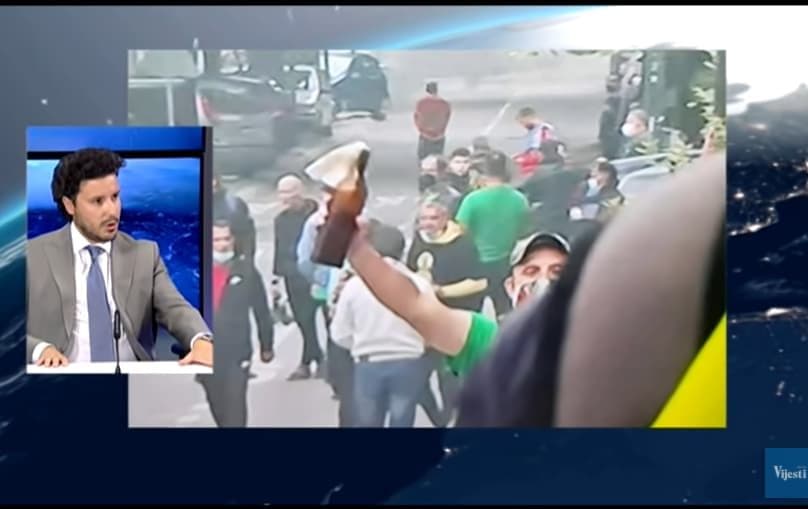
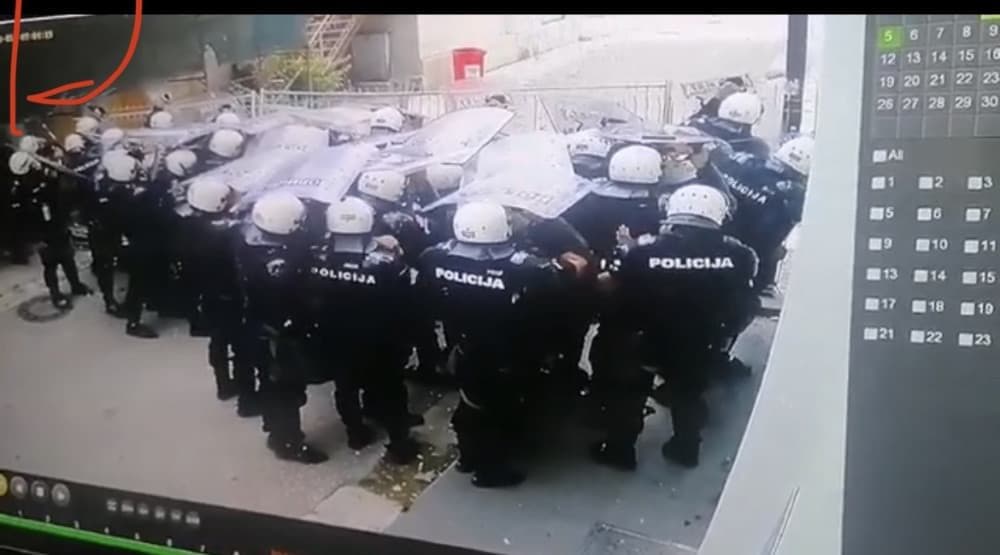
Vijesti received a video from the surveillance cameras on September 7, which showed police officers being attacked by an explosive device resembling the Molotov cocktail.
That media tried to discredit the DFC, thus justifying itself and the government representatives. However, our team promptly reacted, analyzed the mentioned video, and found out that, similarly as with the photo, the time did not coincide with the time when the press release from the Krivokapic’s Office was published, which was subsequently followed by police action. Analyzing the video published on the Vijesti portal at 8:44 p.m. we found out the following:
- The alleged Molotov cocktail, which was a trigger for police action on that morning, was never thrown and cannot be seen in the video published by Vijesti
- By analyzing the video, one can see that the police and protesters were largely confronted and that throwing of the Molotov cocktail from the video cannot possibly be associated with the press release from the Prime Minister’s Office published on the Vijesti portal, to which DFC reacted. The video was made when riots in Cetinje became rampant and almost over, i.e. in the period between 9:15 and 9:30 a.m.
- The time when the video was made was determined based on the digital record from the surveillance cameras, comparative footages from various cameras, and additional forensics of the published video;
- The police fired first tear gas into protesters at Dvorski trg (Court Square) when in other streets in Cetinje there were no confrontations with protesters
- • The mentioned video was made in Decanska Street, which is one of the side streets in Cetinje in which confrontations between the police and protesters happened later, which can be seen in the video published by Vijesti. After all, the logical question rises – why did one of the biggest media outlets in Montenegro and the region, obviously coordinating with the Government of Montenegro, try to deceive the public.
Foreign footprint
The international community was continuously trying to reduce tensions through its appeals, but such an approach proved to be inefficient. Tonino Picula, EP Standing Rapporteur on Montenegro, and Vladimir Bilcik, Chairman of the Delegation to the EU-Montenegro Stabilization and Association Parliamentary Committee, pointed out after the anointment that politicization of religion poorly affects the European path of Montenegro, but also that political abuse of one’s religious beliefs is not compatible with the ongoing reform process of Montenegro, sending a very clear message.
The Russian involvement and activities in Montenegro and Cetinje are best illustrated by the statement of the spokesperson of the Ministry of Foreign Affairs of the Russian Federation Maria Zakharova and Archpriest of the Russian Orthodox Church Igor Yakimchuk about the artificial character of the protest that can be connected with the President of Montenegro, which is identical narrative spread by Metropolitan Joanikije and other pro-Russian actors in the country and the region, whose ultimate goal is to divert Montenegro from its Western course.
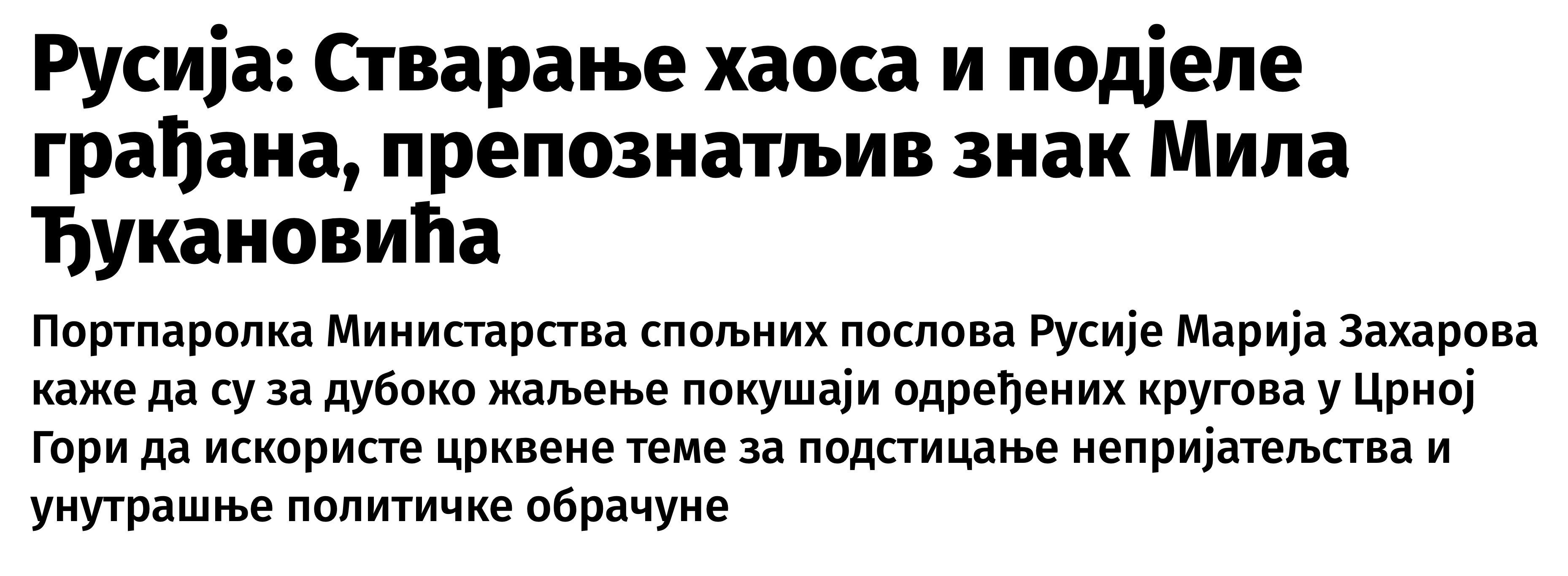


There was no noticeable and open interference of Russia in Cetinje, but its footprint and the use of all instruments from the weaponry of Russian soft power, through proxies in Montenegro and the region were recognizable.
The events in Cetinje showed that neither side intended to back down an inch and that the worsening of the situation with hate speech, incitement, disinformation, and fake news coming from various propaganda kitchens was at the expense of public order and peace authorities. Last weekend, we witnessed moments in which the personal interests of domestic actors take precedence over the common good, while moderate attitudes and reasonable actions are not desirable because they have a hint of backing down.

